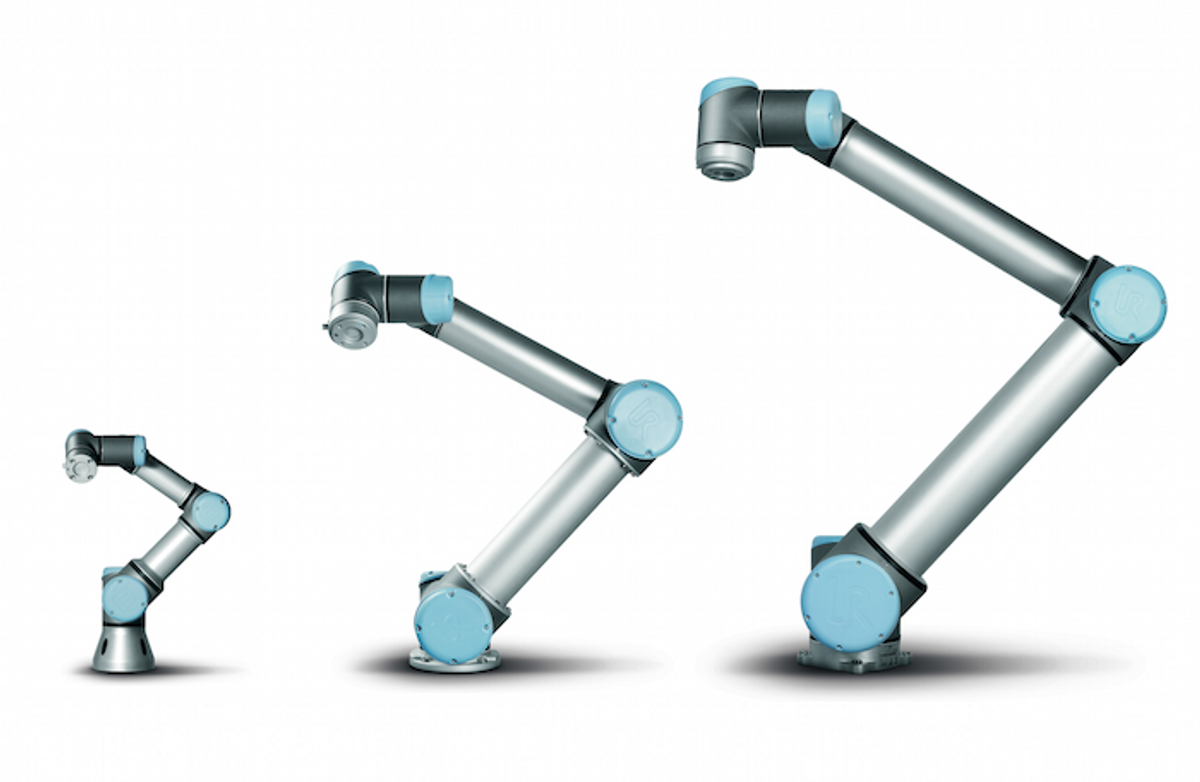This Danish family is growing. Universal Robots, based in Odense, Denmark, is announcing today a new addition to its line of industrial robotic arms. The new arrival is called UR3, and it’s smaller than the company’s earlier models, UR5 and UR10. Compared to its older siblings, the little UR3 looks light and nimble—and even “cute,” as one observer described it.
Universal Robots has been expanding at a rapid pace, selling 2000 robots last year and planning to sell 4000 this year, with expected revenue of $100 million. With a more portable and affordable offering, the company wants to bring robots to companies—especially small and medium businesses—for which automation has been too complex or costly.
The UR3 will sell for US $23,000 in the United States. (The UR5 costs $35,000, and the UR10, $45,000). Like its predecessors, the UR3 is a 6-axis articulated arm that can perform a host of tasks (pick-and-place, soldering, screwing, gluing, painting) in close collaboration with human workers. To program the robot, you can simply grab it, move it around, and tap on a touchscreen to record the desired positions and actions.
Universal Robots is unveiling the UR3 today in Shanghai, China, and it will demonstrate the new robot at the Automate trade show in Chicago next week.

Collaborative robots are one of the hottest trends in industrial automation. Competing with Universal Robots are startups like Rethink Robotics (creator of the two-armed humanoid Baxter) and traditional robot makers such as ABB (which has a “robotic coworker” called FRIDA YuMi), among others.
Unlike traditional industrial robots, which are big, expensive, and work inside safety enclosures, this new generation of collaborative robots is designed to be flexible, easy to program, and safe to operate near people.
Universal Robots CTO and co-founder Esben Østergaard tells IEEE Spectrum that it took three years to develop the UR3. The biggest technical challenge, he said, was miniaturizing their technology, which was already highly compact and integrated. (Read more about what’s inside the UR robots in our interview with CEO Enrico Krog Iversen.)
Here are some UR3 specs:
- Weight: 11 kg
- Payload: 3 kg [UR5: 5 kg; UR10: 10 kg]
- Reach: 50 cm [UR5: 85 cm; UR10: 130 cm]
- Rotation: 360-degree rotation on all wrist joints, infinite rotation on end joint; 360 degrees in 1 second
- Repeatability: ±0.1 mm [same as UR5 and UR10]
- Safety: 15 adjustable settings (force limit default is 150 N; can be adjusted down to 50 N)
- Modular design: exchanging a joint takes less than 30 minutes
- Improved force control
- New motherboard with faster boot-up
Asked if the UR3 is capable of performing electronics assembly tasks, such as placing small components on a circuit board, Østergaard says there are dedicated machines for that. “A traditional robot should probably not try to replace those,” he says. “However, for doing handling and assembly of everything else, the UR3 could prove to be a very good choice.”
I asked him to explain how the “improved force control” works in the new robot, but he declined to give details, noting that the technology “is basically the same as for UR5 and UR10, just developed further.” An interesting feature is the robot’s ability to follow the shape of a part—while applying glue to it, for example—by “feeling” its outline rather than through a pre-configured path (which would be time consuming to program).
Universal Robots is aggressively marketing its robots through a network of 200 sales partners in 50 countries. But it remains to be seen how the UR3 will affect the company’s bottom line; after all, the UR3, which is only slightly smaller than the UR5, could cannibalize sales of the higher priced models in certain projects.
The company says the UR3 is particularly suited for “light assembly tasks and automated workbench scenarios” in a variety of industries. In fact, there’s one application the new robot is already helping with: making copies of itself. Universal Robots has provided robotic arms to several of its suppliers, with the arms helping human workers assemble components that will go into other arms, Østergaard says.
“Our robots are indeed helping to build our robots.”
[ Universal Robots ]
Erico Guizzo is the director of digital innovation at IEEE Spectrum, and cofounder of the IEEE Robots Guide, an award-winning interactive site about robotics. He oversees the operation, integration, and new feature development for all digital properties and platforms, including the Spectrum website, newsletters, CMS, editorial workflow systems, and analytics and AI tools. An IEEE Member, he is an electrical engineer by training and has a master’s degree in science writing from MIT.




